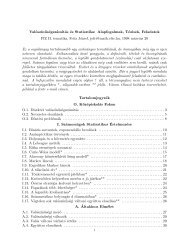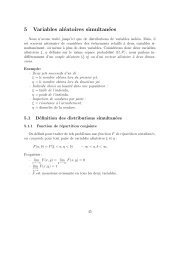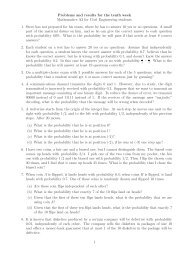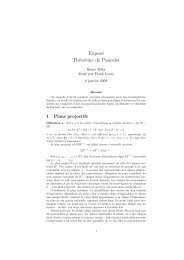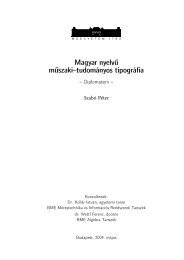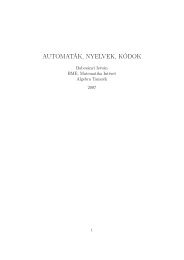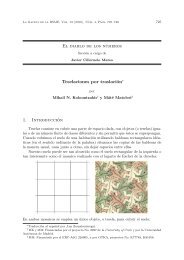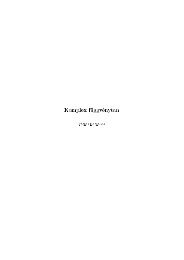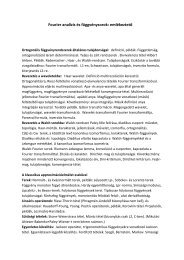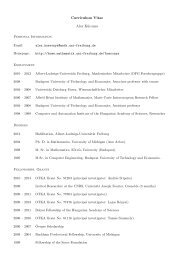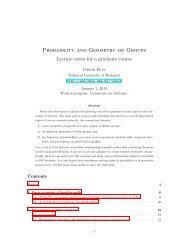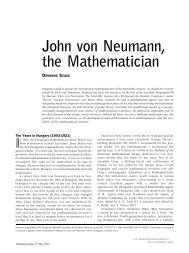Problems and results for the ninth week Mathematics A3 for Civil ...
Problems and results for the ninth week Mathematics A3 for Civil ...
Problems and results for the ninth week Mathematics A3 for Civil ...
You also want an ePaper? Increase the reach of your titles
YUMPU automatically turns print PDFs into web optimized ePapers that Google loves.
<strong>Problems</strong> <strong>and</strong> <strong>results</strong> <strong>for</strong> <strong>the</strong> <strong>ninth</strong> <strong>week</strong><br />
Ma<strong>the</strong>matics <strong>A3</strong> <strong>for</strong> <strong>Civil</strong> Engineering students<br />
1. Production line I of a factory works 60% of time, while production line II works 70% of time,<br />
independently of each o<strong>the</strong>r. What is <strong>the</strong> probability that<br />
(a) both lines operate,<br />
(b) at least one of <strong>the</strong> lines operates,<br />
(c) precisely one of <strong>the</strong> lines operates,<br />
(d) both lines are stopped?<br />
2. Suppose that each child born to a couple is equally likely to be a boy or a girl independent<br />
of <strong>the</strong> sex distribution of <strong>the</strong> o<strong>the</strong>r children of <strong>the</strong> family. For a couple having 5 children,<br />
compute <strong>the</strong> probabilities of <strong>the</strong> following events:<br />
(a) All children are of <strong>the</strong> same sex.<br />
(b) The 3 eldest are boys <strong>and</strong> <strong>the</strong> o<strong>the</strong>rs girls.<br />
(c) Exactly 3 are boys.<br />
(d) The 2 oldest are girls.<br />
(e) There is at least 1 girl.<br />
3. We roll a red <strong>and</strong> a green die. Consider <strong>the</strong> following events: A = {<strong>the</strong> sum of <strong>the</strong> numbers<br />
shown is 7}, B = {at least one of <strong>the</strong> dice shows a 6}, C = {both dice show odd numbers},<br />
D = {<strong>the</strong> dice show different numbers}, E = {<strong>the</strong> green die shows a 4}.<br />
(a) Are <strong>the</strong> events A <strong>and</strong> C independent?<br />
(b) Are <strong>the</strong> events A <strong>and</strong> C mutually exclusive?<br />
(c) What is <strong>the</strong> probability of B?<br />
(d) How are A <strong>and</strong> D related? What consequences follow <strong>for</strong> <strong>the</strong>ir probabilities? And <strong>for</strong><br />
<strong>the</strong>ir independence?<br />
(e) Are <strong>the</strong> events A <strong>and</strong> E independent?<br />
(f) Based on <strong>the</strong> above, show examples of<br />
i. independent but not mutually exclusive events,<br />
ii. mutually exclusive but not independent events.<br />
4. We roll a red <strong>and</strong> a green die. Consider <strong>the</strong> following events: A = {<strong>the</strong> sum of <strong>the</strong> numbers<br />
shown is 7}, B = {<strong>the</strong> red die shows a 3}, C = {<strong>the</strong> green die shows a 4}.<br />
(a) Are <strong>the</strong> events A <strong>and</strong> B independent? The events A <strong>and</strong> C? How about B <strong>and</strong> C?<br />
(b) Are <strong>the</strong> events A, B, C independent?<br />
(c) Are <strong>the</strong> events A <strong>and</strong> B ∩ C independent?<br />
(d) So, are A, B, C independent?<br />
5 ∗ . Suppose that we want to generate <strong>the</strong> outcome of <strong>the</strong> flip of a fair coin but that all we have<br />
at our disposal is a biased coin which l<strong>and</strong>s on heads with some unknown probability p that<br />
need not to be equal to 1/2. Consider <strong>the</strong> following procedure <strong>for</strong> accomplishing our task.<br />
1
(1) Flip <strong>the</strong> coin.<br />
(2) Flip <strong>the</strong> coin again.<br />
(3) If both flips l<strong>and</strong> heads or both l<strong>and</strong> tails <strong>the</strong>n return to step (1).<br />
(4) O<strong>the</strong>rwise, if <strong>the</strong> two flips are different, <strong>the</strong>n let <strong>the</strong> result of <strong>the</strong> last flip be <strong>the</strong> result<br />
of <strong>the</strong> experiment.<br />
(a) Show that <strong>the</strong> result is equally likely to be ei<strong>the</strong>r heads or tails.<br />
(b) Could we use a simpler procedure that continues to flip <strong>the</strong> coin until <strong>the</strong> last two flips<br />
are different <strong>and</strong> <strong>the</strong>n lets <strong>the</strong> result be <strong>the</strong> outcome of <strong>the</strong> final flip?<br />
6. Independent flips of a coin that l<strong>and</strong>s on heads with probability p are made. What is <strong>the</strong><br />
probability that <strong>the</strong> first outcomes are<br />
(a) H, H, H, H,<br />
(b) T, H, H, H?<br />
(c ∗ ) What is <strong>the</strong> probability that <strong>the</strong> pattern (T, H, H, H) occurs be<strong>for</strong>e <strong>the</strong> pattern<br />
(H, H, H, H)? (Hint: How can <strong>the</strong> pattern (H, H, H, H) occur first?)<br />
7. A true-false question is to be posed to a husb<strong>and</strong> <strong>and</strong> wife team on a quiz show. Both <strong>the</strong><br />
husb<strong>and</strong> <strong>and</strong> <strong>the</strong> wife will, independently, give <strong>the</strong> correct answer with probability p. Which<br />
of <strong>the</strong> following is a better strategy <strong>for</strong> this couple?<br />
(a) Choose one of <strong>the</strong>m <strong>and</strong> let that person answer <strong>the</strong> question; or<br />
(b) have <strong>the</strong>m both consider <strong>the</strong> question <strong>and</strong> <strong>the</strong>n ei<strong>the</strong>r give <strong>the</strong> common answer if <strong>the</strong>y<br />
agree or, if <strong>the</strong>y disagree, flip a coin to determine which answer to give?<br />
8. Between cities A, B, C, <strong>the</strong>re are <strong>the</strong> following roads: A −B, A −C <strong>and</strong> B −C. At a winter<br />
night, each of <strong>the</strong>se road gets blocked by <strong>the</strong> snow independently with probability p. What<br />
is <strong>the</strong>n <strong>the</strong> probability that on <strong>the</strong> next morning city C will be accessible from city A?<br />
9. Between cities A, B, C, <strong>the</strong>re are two independent roads between cities A <strong>and</strong> B, <strong>and</strong> ano<strong>the</strong>r<br />
road between B <strong>and</strong> C. If each of <strong>the</strong>se roads gets blocked independently with probability q,<br />
<strong>the</strong>n what is <strong>the</strong> probability that city C will be accessible from city A?<br />
10. Five men <strong>and</strong> 5 women are ranked according to <strong>the</strong>ir scores on an examination. Assume that<br />
no two scores are alike <strong>and</strong> all 10! possible rankings are equally likely. Let X denote <strong>the</strong><br />
highest ranking achieved by a woman (<strong>for</strong> instance, X=1 if <strong>the</strong> top-ranked person is female).<br />
Find <strong>the</strong> probability mass function P{X = i}, i = 1, 2, . . ., 10 of X.<br />
11. The mass function of X is given by p(i) = i2 , i = 1, 2, 3, 4. Compute <strong>the</strong> expectation of X.<br />
30<br />
12. Adam <strong>and</strong> Bob play <strong>the</strong> following game: <strong>the</strong>y both roll a die, <strong>and</strong> Bob gives Adam an amount<br />
equal to <strong>the</strong> square of <strong>the</strong> difference of <strong>the</strong> numbers shown on <strong>the</strong> two dice. Adam gives Bob<br />
an amount equal to <strong>the</strong> sum of <strong>the</strong> two numbers shown on <strong>the</strong> dice. Who is favored by this<br />
game?<br />
13. On a raffle <strong>the</strong>y have one HUF1000000, 10 HUF50000, <strong>and</strong> 100 HUF5000 prizes. They<br />
produce 40000 tickets <strong>for</strong> this raffle. What should <strong>the</strong> price of one ticket be, so that <strong>the</strong><br />
expected return agrees to <strong>the</strong> half of that price?<br />
2
14. Assume <strong>the</strong> fixed prizes of HUF700, HUF10000, HUF789 thous<strong>and</strong>, <strong>and</strong> HUF535 million on<br />
<strong>the</strong> lottery (5 winner numbers out of 90). With a price HUF150 of a lottery ticket, what are<br />
our expected winnings on one lottery ticket?<br />
15. Ann <strong>and</strong> Bob play with two dice. Ann pays Bob whenever both dice show odd numbers. Bob<br />
pays Ann whenever exactly one die shows an even number. In any o<strong>the</strong>r case, no payments<br />
are made. What amounts should <strong>the</strong>y set up to make this game fair?<br />
16. Let X be <strong>the</strong> outcome of rolling a die. Compute <strong>the</strong> expectation <strong>and</strong> st<strong>and</strong>ard deviation of<br />
X. What if <strong>the</strong> ’die’ has n sides?<br />
17. A total of 4 buses carrying 148 students from <strong>the</strong> same school arrive at a football stadium.<br />
The buses carry, respectively, 40, 33, 25, <strong>and</strong> 50 students. One of <strong>the</strong> students is r<strong>and</strong>omly<br />
selected. Let X denote <strong>the</strong> number of students that were on <strong>the</strong> bus carrying this r<strong>and</strong>omly<br />
selected student. One of <strong>the</strong> 4 bus drivers is also r<strong>and</strong>omly selected. Let Y denote <strong>the</strong> number<br />
of students in her bus.<br />
(a) Which of E(X) or E(Y ) do you think is larger? Why?<br />
(b) Compute E(X) <strong>and</strong> E(Y ).<br />
(c) Find Var(X) <strong>and</strong> Var(Y ).<br />
18. We draw without replacement 3 balls from an urn that contains 4 red <strong>and</strong> 6 white balls.<br />
Denote by X <strong>the</strong> number of red balls drawn. Find <strong>the</strong> distribution of X, its expectation <strong>and</strong><br />
st<strong>and</strong>ard deviation.<br />
19. We r<strong>and</strong>omly place a knight on an empty chessboard. What is <strong>the</strong> expected number of his<br />
possible moves? (A knight placed on <strong>the</strong> square (i, j) of <strong>the</strong> chessboard can move to any of<br />
<strong>the</strong> squares (i+2, j +1), (i+1, j +2), (i −1, j +2), (i −2, j +1), (i −2, j −1), (i −1, j −2),<br />
(i + 1, j − 2), (i + 2, j − 1), provided <strong>the</strong>y are on <strong>the</strong> chessboard.)<br />
20. Rolling two dice, what is <strong>the</strong> expected value of <strong>the</strong> higher <strong>and</strong> of <strong>the</strong> smaller of <strong>the</strong> two<br />
numbers shown?<br />
21. One of <strong>the</strong> numbers 1 through 10 is r<strong>and</strong>omly chosen. You are to try to guess <strong>the</strong> number<br />
chosen by asking questions with ” yes-no” answers. Compute <strong>the</strong> expected number of questions<br />
you will need to ask in each of <strong>the</strong> two cases:<br />
(a) Your ith question is to be ” Is it i?”, i = 1, 2, . . ., 10.<br />
(b) With each question you try to eliminate one-half of <strong>the</strong> remaining numbers, as nearly<br />
as possible. For example, your first question is ” Is <strong>the</strong> number larger than 5?”. If yes,<br />
<strong>the</strong>n your second question is ” Is <strong>the</strong> number greater than 7?”, etc.<br />
22. If E(X) = 1 <strong>and</strong> Var(X) = 5, find<br />
(a) E[(2 + X) 2 ],<br />
(b) Var(4 + 3X).<br />
23. Let X be a r<strong>and</strong>om variable having expected value µ <strong>and</strong> variance σ2 . Find <strong>the</strong> expected<br />
value <strong>and</strong> variance of<br />
X − µ<br />
Y : = .<br />
σ<br />
24. How many people are needed so that <strong>the</strong> probability that at least one of <strong>the</strong>m has <strong>the</strong> same<br />
birthday as you is greater than 1/2?<br />
3
1.(a) 0.6 · 0.7 = 0.42<br />
(b) 1 − 0.4 · 0.3 = 0.88<br />
(c) 0.6 · 0.3 + 0.4 · 0.7 = 0.46<br />
(d) 0.4 · 0.3 = 0.12<br />
2.(a) (1/2) 5 + (1/2) 5 = 1/16<br />
(b) 1/32<br />
(c) � � � � 5 1 3 � �<br />
1 2<br />
· · = 5/16<br />
3 2 2<br />
(d) 1 1 · 2 2<br />
(e) 1 − � 1<br />
2<br />
= 1/4<br />
� 5 = 31/32<br />
3.(a) No, because<br />
(b) <strong>the</strong>y are mutually exclusive events.<br />
(c) 1 − P{none of <strong>the</strong>m is 6} = 1 − � �<br />
5 2.<br />
6<br />
Answers<br />
(d) A implies D, that is A ⊂ D. Hence P{A} ≤ P{D}, <strong>and</strong> e.g. 5/6 = P{D} �= P{D | A} = 1<br />
shows that A <strong>and</strong> D cannot be independent.<br />
(e) The event A is realized in 6 cases out of <strong>the</strong> 36 possible outcomes, hence its probability is<br />
1/6. The event E also has probability 1/6, <strong>and</strong> A ∩ E is realized in precisely one case, its<br />
probability is 1/36. There<strong>for</strong>e, P{A} · P{E} = P{A ∩ E}, <strong>the</strong> two events are independent.<br />
(f) i. A <strong>and</strong> E;<br />
ii. A <strong>and</strong> C.<br />
4.(a) P{A} = P{B} = P{C} = 1/6, <strong>and</strong> P{AB} = P{AC} = P{BC} = 1/36, hence A <strong>and</strong> B; A<br />
<strong>and</strong> C; B <strong>and</strong> C are pairwise independent.<br />
(c) Since B ∩ C ⊂ A, B ∩ C <strong>and</strong> A cannot be independent.<br />
(b),(d) A, B, C are not independent. Our result in (c) is an indication of this fact, <strong>and</strong> also 1/36 =<br />
P{A ∩ B ∩ C} �= P{A} · P{B} · P{C} = 1/216.<br />
5 ∗ .(a) The procedure can be re<strong>for</strong>mulated in <strong>the</strong> following way: We flip <strong>the</strong> coin twice. If <strong>the</strong><br />
outcomes agree, <strong>the</strong>n our flips do not matter, we restart <strong>the</strong> experiment. If <strong>the</strong> two outcomes<br />
disagree, <strong>the</strong>n we consider <strong>the</strong> second outcome. From this <strong>for</strong>mulation one can see that <strong>the</strong><br />
outcomes of our procedure follow a conditional distribution:<br />
P{<strong>the</strong> procedure gives H} = P{(T, H) | (T, H) or (H, T)}<br />
=<br />
P{(T, H)}<br />
P{(T, H) or (H, T)} =<br />
Similarly, <strong>the</strong> procedure gives tails with probability 1/2.<br />
4<br />
(1 − p)p 1<br />
=<br />
(1 − p)p + p(1 − p) 2 .
(b) For any 0 < p < 1, we will surely find both heads <strong>and</strong> tails eventually. Thus method (b) gives<br />
H if <strong>and</strong> only if <strong>the</strong> first flip comes out T, which happens with probability 1 −p. The method<br />
gives T if <strong>and</strong> only if <strong>the</strong> first flip is H, this happens with probability p. Hence method (b)<br />
does not give fair coin flip <strong>results</strong>.<br />
The difficulty in this problem is figuring out why our arguments in (a) do not work in <strong>the</strong> case of<br />
method (b). In <strong>the</strong> above <strong>for</strong>mulation of (a) we consider a fixed pair of coin flips (<strong>the</strong> first two<br />
flips), while in method (b) we take a r<strong>and</strong>omly selected pair of coin flips, those where we first see<br />
a change in <strong>the</strong> outcomes. This innocent-looking difference essentially modifies <strong>the</strong> probabilities of<br />
<strong>the</strong> outcomes (H, T) <strong>and</strong> (T, H). Our arguments in (a), applied on case (b), would look like this:<br />
P{<strong>the</strong> procedure gives H} = P{(T, H) | (T, H) or (H, T)}<br />
<strong>and</strong> similarly <strong>the</strong> probability of outcome T is p.<br />
6.(a) p 4<br />
(b) (1 − p) · p 3<br />
=<br />
P{(T, H)} (1 − p)<br />
=<br />
P{(T, H) or (H, T)} (1 − p) + p<br />
= 1 − p,<br />
(c ∗ ) Our first observation is that <strong>for</strong> any 0 < p < 1 we will eventually see <strong>the</strong> pattern (H, H, H, H).<br />
Suppose that <strong>the</strong> first such pattern starts at <strong>the</strong> nth flip. If n > 1, <strong>the</strong>n <strong>the</strong> n − 1th flip<br />
cannot be H since <strong>the</strong>n <strong>the</strong> first (H, H, H, H) pattern would have started be<strong>for</strong>e <strong>the</strong> nth flip.<br />
Hence in this case <strong>the</strong> n − 1th flip is necessarily T, <strong>and</strong> starting with <strong>the</strong> n − 1th flip we see<br />
<strong>the</strong> pattern (T, H, H, H, H). In that sequence, (T, H, H, H) appears be<strong>for</strong>e (H, H, H, H).<br />
Summarizing, (H, H, H, H) can only appear be<strong>for</strong>e (T, H, H, H) if it starts immediately at<br />
<strong>the</strong> n = 1st flip, that is if all four first flips are heads. The probability of that is p 4 .<br />
7. In case (a) <strong>the</strong> correct answer is given with probability p. In case (b), define E as <strong>the</strong> event that<br />
<strong>the</strong> team gives <strong>the</strong> correct answer, C <strong>and</strong> W, respectively, <strong>the</strong> events that <strong>the</strong> wife or <strong>the</strong> husb<strong>and</strong><br />
would give <strong>the</strong> correct or <strong>the</strong> wrong answer (that is, e.g. (C, C) is <strong>the</strong> event that <strong>the</strong>y both would<br />
give <strong>the</strong> correct answer). Then<br />
P{E} = P{E | (C, C)} · P{(C, C)} + P{E | (C, W)} · P{(C, W)}<br />
+ P{E | (W, C)} · P{(W, C)} + P{E | (W, W)} · P{(W, W)}<br />
= 1 · p 2 + 1 1<br />
· p(1 − p) +<br />
2 2 · (1 − p)p + 0 · (1 − p)2 = p.<br />
There is no difference between <strong>the</strong> two strategies. A strategy similar to (b) would be favorable <strong>for</strong><br />
larger teams (<strong>and</strong> p > 1/2).<br />
8. Denote <strong>the</strong> event in question by A � C, <strong>and</strong> <strong>the</strong> event that <strong>the</strong> road A − B is not blocked by<br />
A ↔ B. Then<br />
P{A � C} = P{A � C | A ↔ C} · (1 − p) + P{A � C | A � C} · p<br />
= 1 · (1 − p) + P{A ↔ B, B ↔ C} · p = 1 − p + (1 − p) 2 · p.<br />
9. With <strong>the</strong> notation of <strong>the</strong> previous problem, <strong>the</strong> events A � B <strong>and</strong> B � C are independent.<br />
Hence<br />
P{A � C} = P{A � B} · P{B � C} = [1 − q 2 ] · (1 − q).<br />
10. Clearly <strong>the</strong> probability is zero if i > 6.<br />
5
Without order: If we only consider <strong>the</strong> sex of <strong>the</strong> contestants, <strong>the</strong>n each of <strong>the</strong> � � 10<br />
possible orders<br />
5<br />
are equally likely. Out of <strong>the</strong>se we have to count how many will give men <strong>for</strong> <strong>the</strong> first i−1 positions,<br />
<strong>the</strong>n a woman on <strong>the</strong> ith position. In o<strong>the</strong>r words we have to count <strong>the</strong> number of ways 4 women<br />
<strong>and</strong> 5 − (i − 1) = 6 − i men can be arranged on <strong>the</strong> 10 − i positions behind <strong>the</strong> first woman. The<br />
answer is � � 10−i<br />
, <strong>and</strong> <strong>the</strong> probability in question is<br />
4<br />
� � 10−i<br />
4 (10 − i)! · 5! · 5! (10 − i)! · 5 · 5!<br />
� � 10 = = .<br />
10! · 4! · (6 − i)! 10! · (6 − i)!<br />
5<br />
With order: In this case all contestants are considered different. We have to count that, out of <strong>the</strong><br />
10! possible orders, in how many cases are <strong>the</strong>re men on <strong>the</strong> first i − 1 positions, <strong>and</strong> a woman on<br />
<strong>the</strong> ith position. For <strong>the</strong> first i − 1 positions we can arrange men in 5!/[5 − (i − 1)]! = 5!/(6 − i)!<br />
many ways (i − 1 permutations of 5 men). Then we have 5 choices <strong>for</strong> selecting <strong>the</strong> woman at<br />
position i, <strong>the</strong>n (10 − i)! ways to arrange <strong>the</strong> remaining contestants on <strong>the</strong> 10 − i positions left.<br />
The probability in question is thus<br />
5! · 5 · (10 − i)!<br />
.<br />
(6 − i)! · 10!<br />
The answers <strong>for</strong> i = 1, 2, 3, 4, 5 <strong>and</strong> 6 are, respectively, 1/2, 5/18, 5/36, 5/84, 5/252, 1/252.<br />
11.<br />
E(X) =<br />
4�<br />
i · p(i) =<br />
i=1<br />
4�<br />
i=1<br />
i3 13 23 33 43 10<br />
= + + + =<br />
30 30 30 30 30 3 .<br />
12. Let X be <strong>the</strong> square of <strong>the</strong> difference of <strong>the</strong> numbers shown by <strong>the</strong> two dice. Then X has mass<br />
function p(0) = 1/6, p(1) = 10/36, p(4) = 8/36, p(9) = 6/36, p(16) = 4/36, p(25) = 2/36, <strong>and</strong><br />
expectation<br />
E(X) = 0 · 1 10 8 6 4 2 210 35<br />
+ 1 · + 4 · + 9 · + 16 · + 25 · = =<br />
6 36 36 36 36 36 36 6 .<br />
Similarly, Y is <strong>the</strong> sum of <strong>the</strong> two numbers, its mass function is p(2) = p(12) = 1/36, p(3) =<br />
p(11) = 2/36, p(4) = p(10) = 3/36, p(5) = p(9) = 4/36, p(6) = p(8) = 5/36, p(7) = 6/36, <strong>and</strong> its<br />
expectation is 7=42/6. Hence <strong>the</strong> game favors Bob in <strong>the</strong> long run.<br />
13. The expected return are<br />
1<br />
10<br />
100<br />
· HUF1 000 000 + · HUF50 000 + · HUF5 000 = HUF50,<br />
40 000 40 000 40 000<br />
so tickets should be sold <strong>for</strong> HUF100.<br />
14. The expected return is<br />
� � � � � � � �<br />
5 85 5 85<br />
· · 2 3 3 2<br />
� · 700 + � · 10 000 +<br />
� 90<br />
5<br />
� 90<br />
5<br />
�5 4<br />
� � � 85<br />
· 1 � · 789 000 + 1<br />
� · 535 000 000 ≃ HUF43. 66 .<br />
If tickets cost HUF150, <strong>the</strong>n on average we loose HUF106. 34 on each ticket.<br />
� 90<br />
5<br />
15 Ann pays Bob with probability 1 1<br />
1 1 1 1<br />
· = 1/4, <strong>and</strong> Bob pays Ann with probability · + · = 1/2.<br />
2 2 2 2 2 2<br />
The game is fair if Ann pays twice <strong>the</strong> amount that Bob pays, e.g. 2 tokens while Bob pays 1 token.<br />
16 In case of an n sided ’die’, <strong>the</strong> mass function of X is p(i) = 1/n, i = 1, 2, . . .n. With <strong>the</strong> sum<br />
<strong>for</strong>mula <strong>for</strong> <strong>the</strong> arithmetic sequence,<br />
E(X) =<br />
n�<br />
i=1<br />
i · p(i) = 1<br />
n<br />
n�<br />
i=1<br />
6<br />
� 90<br />
5<br />
i = 1 n(n + 1)<br />
· =<br />
n 2<br />
n + 1<br />
.<br />
2
For <strong>the</strong> st<strong>and</strong>ard deviation we need <strong>the</strong> second moment as well, <strong>and</strong> we use <strong>the</strong> sum <strong>for</strong>mula <strong>for</strong><br />
<strong>the</strong> square numbers:<br />
E(X 2 ) =<br />
n�<br />
i=1<br />
The st<strong>and</strong>ard deviation is <strong>the</strong>n<br />
i 2 · p(i) = 1<br />
n<br />
n�<br />
i=1<br />
SD(X) = � E(X 2 ) − [E(X)] 2 =<br />
i 2 = 1<br />
n · 2n3 + 3n2 + n<br />
6<br />
� 2n 2 + 3n + 1<br />
6<br />
− n2 + 2n + 1<br />
4<br />
For an ordinary die we have n = 6, E(X) = 7/2, SD(X) = � 35/12.<br />
= 2n2 + 3n + 1<br />
.<br />
6<br />
=<br />
� n 2 − 1<br />
12 .<br />
17.(a) We have a greater chance of choosing a student from a crowded bus, while we pick each bus<br />
with equal chance when choosing one of <strong>the</strong> drivers. There<strong>for</strong>e we expect X to be greater<br />
than Y .<br />
(b) Using <strong>the</strong> mass function of X,<br />
E(X) = 40 · 40 33 25 50<br />
+ 33 · + 25 · + 50 · ≃ 39.28.<br />
148 148 148 148<br />
As Y takes on any of <strong>the</strong> given values with equal chance,<br />
E(Y ) = 40 · 1 1 1 1<br />
+ 33 · + 25 · + 50 · = 37.<br />
4 4 4 4<br />
(c) For <strong>the</strong> st<strong>and</strong>ard deviation we determine <strong>the</strong> second moments:<br />
E(X 2 ) = 40 2 · 40<br />
148 + 332 · 33<br />
148 + 252 · 25<br />
148 + 502 · 50<br />
≃ 1625.4,<br />
148<br />
E(Y 2 ) = 40 2 · 1<br />
4 + 332 · 1<br />
4 + 252 · 1<br />
4 + 502 · 1<br />
= 1453.5.<br />
4<br />
The st<strong>and</strong>ard deviations are <strong>the</strong>n<br />
18. The mass function of X is:<br />
� � � � 4 6<br />
· 0 3 p(0) = � = 1<br />
, p(1) =<br />
6<br />
Then<br />
� 10<br />
3<br />
SD(X) = � E(X 2 ) − [E(X) 2 ] ≃ √ 1625.4 − 39.28 2 ≃ 9.06,<br />
SD(Y ) = � E(Y 2 ) − [E(Y ) 2 ] ≃ √ 1453.5 − 37 2 ≃ 9.19.<br />
�4 1�10<br />
3<br />
� � � 6<br />
· 2 � = 1<br />
, p(2) =<br />
2<br />
�4 2�10<br />
3<br />
� � � 6<br />
· 1 � = 3<br />
, p(3) =<br />
10<br />
E(X) = 0 · 1 1 3 1 6<br />
+ 1 · + 2 · + 3 · =<br />
6 2 10 30 5 ,<br />
E(X 2 ) = 0 2 · 1<br />
6 + 12 · 1<br />
2 + 22 · 3<br />
10 + 32 · 1<br />
= 2,<br />
30<br />
SD(X) = � E(X 2 ) − [E(X)] 2 = � 2 − [6/5] 2 = √ 14/5.<br />
�4 3�10<br />
3<br />
� � � 6<br />
· 0 � = 1<br />
30 .<br />
21.(a) Let X be <strong>the</strong> r<strong>and</strong>om number to be found out. Our method needs <strong>the</strong> number of questions<br />
equal to <strong>the</strong> value of X. Hence <strong>the</strong> answer is E(X) = 5.5.<br />
7
(b) Let our strategy be <strong>the</strong> following:<br />
> 5?<br />
✟<br />
n<br />
✟<br />
✟<br />
✟<br />
✟✙ ✟<br />
❍<br />
❍❍❍❍❍❥ y<br />
> 3? > 7?<br />
✟<br />
n<br />
✟<br />
✟<br />
✟<br />
✟✙ ✟<br />
❅ y<br />
❅❅❘<br />
n �<br />
��✠<br />
❍<br />
❍❍❍❍❍❥ y<br />
> 1? > 4? > 6? > 9?<br />
n<br />
y �<br />
❄<br />
1 > 2? 4 5 6 7 > 8? 10<br />
❅ ❅❅❘ n<br />
�<br />
�✠<br />
y<br />
❄<br />
n<br />
❄<br />
❅ ❅<br />
❅❘<br />
n<br />
��✠<br />
y �<br />
n �<br />
�<br />
�✠<br />
y<br />
❄<br />
n<br />
❄<br />
2 3 8 9<br />
❅ y<br />
❅<br />
❅❘<br />
Our first question is whe<strong>the</strong>r <strong>the</strong> number is greater than 5. With all <strong>the</strong> questions we <strong>the</strong>n try<br />
to eliminate half of <strong>the</strong> possibilities left. We need three questions if <strong>and</strong> only if <strong>the</strong> r<strong>and</strong>om<br />
number is 1,4,5,6,7, or 10 (that is, with probability 6/10), <strong>and</strong> four questions if <strong>and</strong> only<br />
if <strong>the</strong> number is 2,3,8, or 9 (with probability 4/10). The expected number of questions is<br />
hence 3 · 6<br />
10<br />
+ 4 · 4<br />
10<br />
= 17<br />
5<br />
= 3.4. For a r<strong>and</strong>om number between 1 <strong>and</strong> 10 <strong>the</strong> two methods do<br />
not show an essential difference in length, but indeed method (b) is much faster <strong>for</strong> finding<br />
out large r<strong>and</strong>om numbers.<br />
22.(a) E[(2+X) 2 ] = E(4)+E(4X)+E(X 2 ) = 4+4E(X)+Var(X)+[E(X)] 2 = 4+4·1+5+1 2 = 14.<br />
(b) Additive constants do not matter <strong>for</strong> <strong>the</strong> variance, <strong>and</strong> multiplicative constants are factored<br />
out as squares. There<strong>for</strong>e Var(4 + 3X) = 3 2 · Var(X) = 9 · 5 = 45.<br />
23.<br />
�<br />
1 µ<br />
�<br />
E(Y ) = E · X − =<br />
σ σ<br />
1 µ<br />
· E(X) − = 0,<br />
σ σ<br />
�<br />
1 µ<br />
�<br />
Var(Y ) = Var · X − =<br />
σ σ<br />
1<br />
σ2Var(X) = 1,<br />
hence SD(Y ) = 1. Y is called <strong>the</strong> st<strong>and</strong>ardized of X.<br />
24. The probability that I do not have a common birthday with any of n people is � �<br />
364 n<br />
(not 365<br />
counting leap years). The probability that at least one of <strong>the</strong> n people shares birthday with me is<br />
1 − � �<br />
364 n.<br />
Hence I need to find n <strong>for</strong> which<br />
365<br />
�<br />
364<br />
�n 1 − ≥<br />
365<br />
1<br />
2<br />
�<br />
364<br />
�n ≤<br />
365<br />
1<br />
2<br />
�<br />
364<br />
�<br />
n · log2 ≤ −1<br />
365<br />
1<br />
n ≥<br />
≃ 252.7,<br />
log2(365) − log2(364) that is at least 253 persons are needed.<br />
8<br />
y<br />
❄



